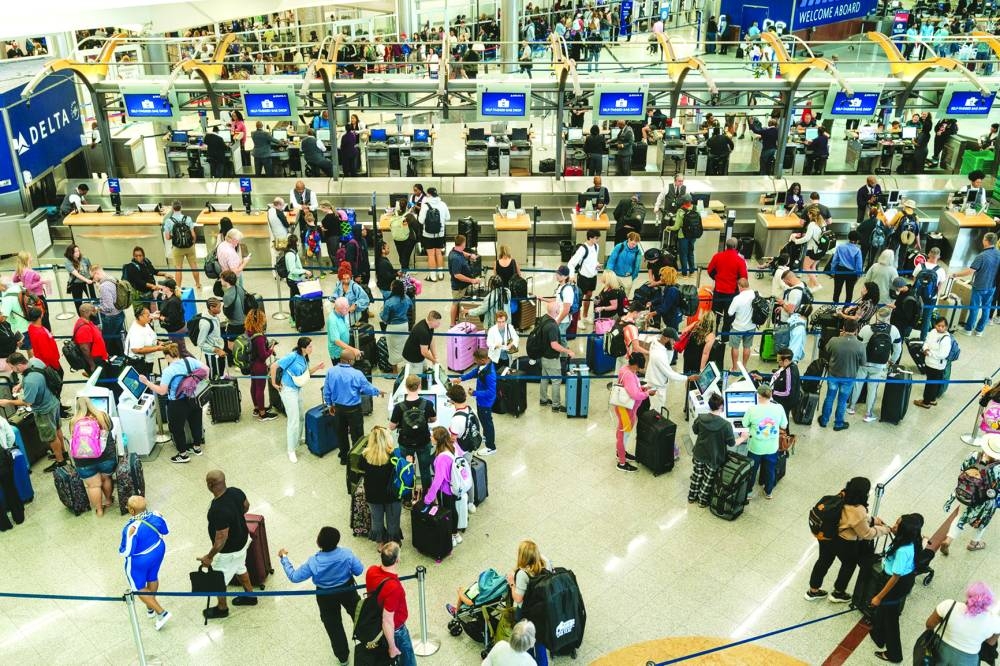Business
International travel back on track demonstrating sector's resilience, enduring desire to fly

Travellers at Hartsfield-Jackson Atlanta International Airport. The Covid-19 pandemic severely impacted the travel and tourism sector, leading to disruptions, job losses, and economic challenges. However, as the world recovers from the pandemic, the sector is expected to regain its significance and contribute to global economic recovery and growth.
The Covid-19 pandemic severely impacted the travel and tourism sector, leading to disruptions, job losses, and economic challenges.
However, as the world recovers from the pandemic, the sector is expected to regain its significance and contribute to global economic recovery and growth.
According to global tourism body, World Travel & Tourism Council (WTTC), nearly half of the 185 countries will have either fully recovered to pre-pandemic levels or be within 95% of full recovery by the end of 2023.
In 2023, the sector is forecast to reach $9.5tn, just 5% below 2019 pre-pandemic levels when travel was at its highest. Some 34 countries have already exceeded the 2019 levels.
The recovery will speed up this year as Chinese travellers re-enter the market, WTTC noted in a research paper recently. The decision by the Chinese government to reopen its borders from early this year will propel the sector and see it recover to pre-pandemic levels in 2023 and beyond.
According to the research conducted by WTTC in collaboration with Oxford Economics, the global tourism body also forecasts that the sector will recover to 95% of the 2019 job level.
Travel and tourism provides 300mn jobs worldwide, the global tourism body says.
Over the next 10 years, the global tourism body is forecasting that the sector will grow its GDP contribution to $15.5tn by 2033 representing 11.6% of the global economy.
By 2033, the sector will employ 430mn people around the world, with almost 12% of the working population employed in the sector.
Last year, despite the economic and geopolitical difficulties, the travel and tourism sector’s recovery continued at pace, growing 22% year-on-year to reach $7.7tn.
This recovery represented 7.6% of the global economy in 2022, the highest sector contribution since 2019, although its global GDP is still 22.9% behind its 2019 peak.
In 2021 the global sector grew 24.7% year-on-year, and last year it grew a further 22% to reach a GDP contribution of $7.7tn.
The research shows that the ongoing conflict in Ukraine and prolonged travel restrictions imposed by a number of countries such as China had a significant impact on the global recovery. But the recent decision by the Chinese government to reopen its borders will propel the sector and see it recover to pre-pandemic levels next year.
From a pre-pandemic high of more than 334mn, the Covid-19 pandemic ravaged employment in the sector which saw losses of more than 70mn to bring the total number employed in 2020 to just 264mn.
Following the recovery of 11mn jobs in 2021, the sector created 21.6mn new jobs in 2022 to reach more than 295mn globally – one in 11 jobs worldwide.
Spending from overseas visitors grew by a record 82% to reach $1.1tn in 2022, showing that international travel is firmly back on track.
WTTC President & CEO, Julia Simpson said: “The travel and tourism sector continues to recover at pace, demonstrating the resilience of the sector and the enduring desire to travel.
“By the end of the year, the sector’s contribution will be within touching distance of the 2019 peak. We expect 2024 to exceed 2019. Travel and tourism will be a growth sector over the next ten years.”
The travel and tourism sector has a significant impact on the global economy, contributing to economic growth, job creation, foreign exchange earnings, and infrastructure development.
It stimulates various sectors, such as hospitality, transportation, entertainment, and retail. As people travel, they spend money on accommodation, food, attractions, shopping, and transportation, generating revenue for businesses and governments.
The travel and tourism segment is a major employer worldwide, creating direct and indirect employment opportunities in areas like hotels, restaurants, airlines, travel agencies, tour operators, transportation services, and tourist attractions.
This obviously helps reduce unemployment rates and improve livelihoods, particularly in regions heavily dependent on tourism.
The sector generates foreign exchange earnings through international tourism. When visitors from other countries spend money within a destination, it contributes to the local economy and helps balance trade deficits.
Countries with attractive tourism offerings can benefit from a steady inflow of foreign currency, which supports economic stability and development.
To accommodate tourists, destinations invest in infrastructure development, including airports, roads, hotels, restaurants, and recreational facilities. This leads to improvements in public services and creates a favourable environment for business and investment. Infrastructure development also benefits local communities and residents by enhancing their quality of life.
According to industry analysts, the travel and tourism sector acts as a natural catalyst for other industries such as agriculture, manufacturing, and handicrafts.
As tourism grows, it jacks up the demand for local products and services, thereby benefiting various sectors of global economy.
Pratap John is Business Editor at Gulf Times. Twitter handle: @PratapJohn

